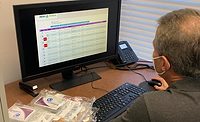The Boston subway system is being used to test new sensors for biological agents over the next six months, according to an article from Product Design & Development.
The Department of Homeland Security’s Science and Technology Directorate has scheduled a series of tests to measure the real-world performance of new sensors recently developed to detect these agents through the “Detect-to-Protect” (D2P Bio Detection project. The devices, with “trigger” and “confirmer” sensors, have been designed to identify and confirm the release of biological agents within minutes, the article says.
In 2009 and early August this year, inert gasses were released into the Boston subway system in an initial study to determine where and how released particulates would travel through the subway network, as well as to identify where to place the new sensors, the article says.
The current studies will involve the release of a small amount of an innocuous killed bacterium in subway stations in the Boston area. After the stations close, scientists will spray small quantities of Bacillus subtilis in the tunnels.
This common, food-grade bacterium is found everywhere in soil, water, air and decomposing plant matter, and it is considered nontoxic to humans, animals and plants even while the bacterium lives, the article says.
S&T’s Dr. Anne Hultgren, manager of the D2P project, says, “While there is no known threat of a biological attack on subway systems in the United States, the S&T testing will help determine whether the new sensors can quickly detect biological agents in order to trigger a public safety response as quickly as possible.”
According to the article, the particles released in the stations will dissipate quickly.





